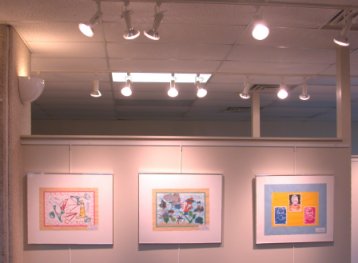Once the matting and framing is finished, the piece is ready for hanging. There are a few things to keep in mind when deciding on where to hang or display a piece of art or a photograph. Many of the considerations are the same as deciding on where to store art and photographs: temperature and humidity levels, stability of the environment, dust, light, pollution, etc. With display of items, however, there are a few additional considerations to keep in mind.
|
There are some very prominent places to display a beautiful original piece of art or large family photographs. One is over the mantel in the living room. This prominent place is very dangerous to original art and photographs. If the fireplace is used at all, the smoke, soot and ashes can do a lot of damage to anything stored above it, including any knickknacks that might be displayed on the mantel. Damage is also caused by the heat of the fire and by the changes in temperature caused by lighting a fire and then allowing it to go out. If the fireplace is never used, the chimney can still be considered an outside wall unless it is bricked up. |
||
|
Fireplace in the Dixie Plantation at
Montecello, FL. From the Florida Photographic Collection
|
Outside walls are not good places to hang original art or photographs. The hot Florida days changing to cooler evening temperatures (and back again) can cause the walls to "sweat." This moisture will transfer itself to anything that is touching the wall - including pictures, tapestries, book cases, and the back of a sofa.
Light does much damage to framed or displayed items. For instance, light can cause dyes to fade rapidly, especially in color photographs. Light is also a source of heat. A glazed frame or display case can act like a miniature greenhouse. The higher levels of heat can cause condensation and also increase the speed of dyes fading or paper becoming brittle.
 |
|
When hanging a picture, be aware of whether sunlight will hit it directly or if it will be underneath another direct source of light. It is hard to see pictures without lighting, but indirect lighting will be less harmful to a framed item. Hot spotlights (as in the picture above) are extremely bad for displayed items.
Preservation matting and framing can help to protect photographs and art from dust and pollution. However, it is also advisable to have an air filtration device in the display area with a high efficiency filter. HEPA filters are available at hardware and department stores.




